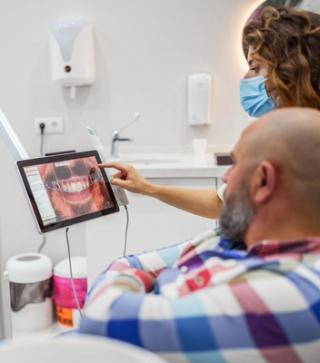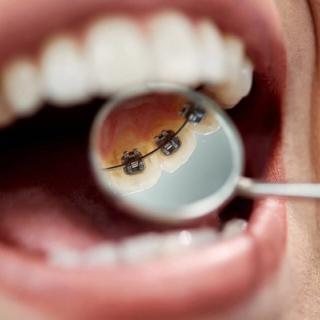What are your teeth straightening options?

Orthodontic treatments can help with a range of oral health issues and concerns, from the visual appearance of your teeth—such as teeth that are crooked or stick out—through to problems with everyday activities such as speaking and breathing.
Thanks to modern dental technology, today’s teeth straightening options are more discreet, comfortable, and fast-acting, helping you straighten crooked teeth and achieve a beautiful, healthy smile while improving your oral health.
Read on to discover more about the different types of orthodontic treatment available.
What is orthodontics?
Orthodontics is a specialised field of dentistry that focuses on diagnosing, preventing, and correcting misaligned teeth and jaw issues. Treatment options vary, from traditional braces to clear aligners, depending on the complexity of the case.

What is orthodontic treatment?
Orthodontic treatment is a type of dental procedure designed to straighten your teeth and correct problems with the bite—the way in which the upper and lower jaws meet when your mouth closes.
Orthodontic treatment takes time and can vary in duration and cost depending on the complexity of the case.
What is an orthodontist?
An orthodontist is a dentist who specialises in orthodontic treatment, helping to straighten teeth, correct bite issues, and improve overall dental alignment.
They assess jaw and teeth development in children and create personalised treatment plans for both kids and adults.
What types of orthodontic treatments are available?
You’ll find a wide range of orthodontic treatments available at your local National Dental Care or DB Dental practice.
The type of orthodontic treatment you receive will depend on the nature of your teeth and jaws, and what you’re aiming to achieve from treatment.
How to know if you need treth straightening?
If you’re wondering whether you need teeth straightening, consider the following signs:
- Crooked or Overlapping Teeth: If your teeth are not aligned properly, it may be time to consider orthodontic treatment.
- Gaps Between Teeth: Spaces between your teeth can affect your smile and may lead to other dental issues.
- Difficulty Chewing or Speaking: Misaligned teeth can make it challenging to chew food properly or speak clearly.
- Jaw Pain or TMJ Disorders: Pain in your jaw or issues with your temporomandibular joint (TMJ) can be a sign that your teeth and bite need correction.
- Upper Teeth Overlapping Lower Teeth: If your upper teeth significantly overlap your lower teeth, it may indicate a bite issue that needs addressing.
- Lower Teeth Crowded or Overlapping: Crowded or overlapping lower teeth can be difficult to clean and may lead to dental problems.
- Missing Teeth or Teeth Not in Proper Position: Missing teeth or teeth that are not in their correct position can affect your bite and overall dental health.
Consult with an orthodontist to determine if teeth straightening is right for you. They will assess your teeth and bite to recommend the best course of treatment.
Types of orthodontic treatments available
You’ll find a wide range of orthodontic treatments available at your local National Dental Care or DB Dental practice.
The type of orthodontic treatment you receive will depend on the condition of your teeth and jaws, as well as what you want to achieve from treatment.
Here are some of the orthodontic treatments we offer:
Fixed braces
Also known as fixed braces, orthodontic braces are made of high-quality metal or ceramic brackets connected by a special type of wire and attached to each tooth. Adjustments are made over the course of your treatment until your teeth are in the desired position.
Fixed braces can address issues such as crowded or crooked teeth, underbites, overbites and crossbites, limited breathing, and unevenly spaced teeth.
Treatment time for fixed braces can range from as little as six months up to 24 months, depending on the complexity of your treatment (in most cases, fixed braces are worn for 12-18 months).
Types of fixed braces



Clear aligners for crooked teeth
One of the most popular types of orthodontic treatments for adults, clear aligners such as Invisalign® are virtually invisible. They work by applying targeted pressure to your teeth in order to gradually move them into alignment.
The benefits of clear aligners include their practically invisible appearance, their comfortable, custom-made fit, and the fact they’re removable for added convenience. What’s more, clear aligners can usually straighten your teeth in a shorter amount of time.
Is Invisalign® bad for your teeth?
No - Invisalign® offers the same great benefits as traditional dental braces, but without the more visible apparatus for treatment. Using Invisalign to straighten your teeth and add confidence to your smile won’t result in any damage or problems for your teeth.
Speak to your Invisalign dentist if you have any questions or concerns.
Orthodontic plates and retainers
Orthodontic plates are a good option for young children who have particular problems with tooth or jaw alignment, as this treatment will carefully adjust the growth of the jawbone and arrange the teeth correctly.
An orthodontic plate or retainer is made of plastic or wire that is shaped to fit around the top or bottom teeth, in order to hold them in place or gently guide them into the desired position.

Using orthodontic plates at a young age can greatly reduce or even eliminate the need for braces later in life.
What is the best age for braces
Many orthodontists will recommend that braces are applied between the ages of 10 and 14. This is the time when teeth are most receptive to changes, although you will need to wait until you have all of your adult teeth before getting braces.
Orthodontic treatment isn’t just for kids—anyone can benefit from it. Whether you choose dental braces or Invisalign, you can enjoy straighter, healthier teeth and a more confident smile.
What to expect during treatment?
During orthodontic treatment, you can expect the following:
- Initial Consultation: Your orthodontist will examine your teeth and bite to determine the best treatment plan. This is your opportunity to discuss your concerns and goals for treatment.
- Impressions and X-rays: To create a personalized treatment plan, your orthodontist will take impressions of your teeth and X-rays. These tools help in designing the most effective approach to straighten your teeth.
- Appliance Placement: Your orthodontist will place orthodontic appliances, such as braces or aligners, to begin the straightening process. This step marks the start of your journey towards a straighter smile.
- Regular Adjustments: You’ll need to visit your orthodontist regularly for adjustments to ensure proper tooth movement. These appointments are crucial for tracking progress and making necessary modifications.
Treatment Duration: Orthodontic treatment typically takes 1-3 years, depending on the severity of your case. Your orthodontist will provide an estimated timeline based on your specific needs.
Aftercare and maintenance
After orthodontic treatment, it’s essential to maintain good oral hygiene and follow your orthodontist’s instructions to ensure long-lasting results. This includes:
- Wearing Retainers: Removable retainers or permanent retainers can help maintain tooth alignment. Your orthodontist will advise you on how long to wear them to keep your teeth in their new position.
- Regular Check-ups: Schedule regular check-ups with your orthodontist to monitor tooth movement and address any concerns. These visits are important for ensuring your teeth remain properly aligned.
- Good Oral Hygiene: Brush and floss regularly to prevent tooth decay and gum disease. Maintaining a clean mouth is crucial for the health of your teeth and gums.
- Avoiding Bad Habits: Avoid habits like thumb-sucking or nail-biting, which can affect tooth alignment. These habits can undo the progress made during your orthodontic treatment.
By following these tips, you can enjoy a beautiful, straight smile for years to come.
Make an orthodontist appointment today!
Need to make an appointment to see an orthodontist? You can find your nearest orthodontist and book online with our esteemed dentists today.

